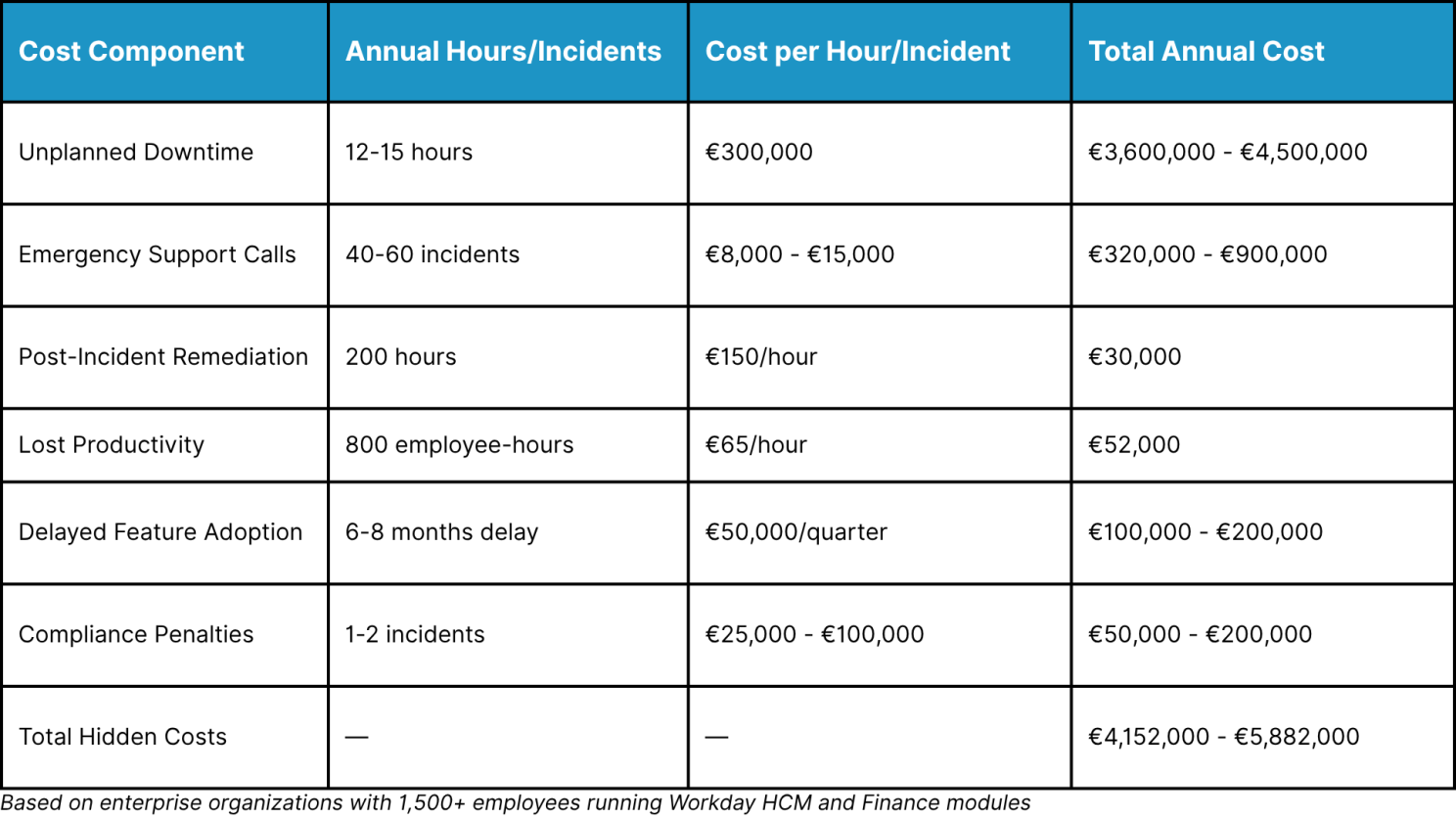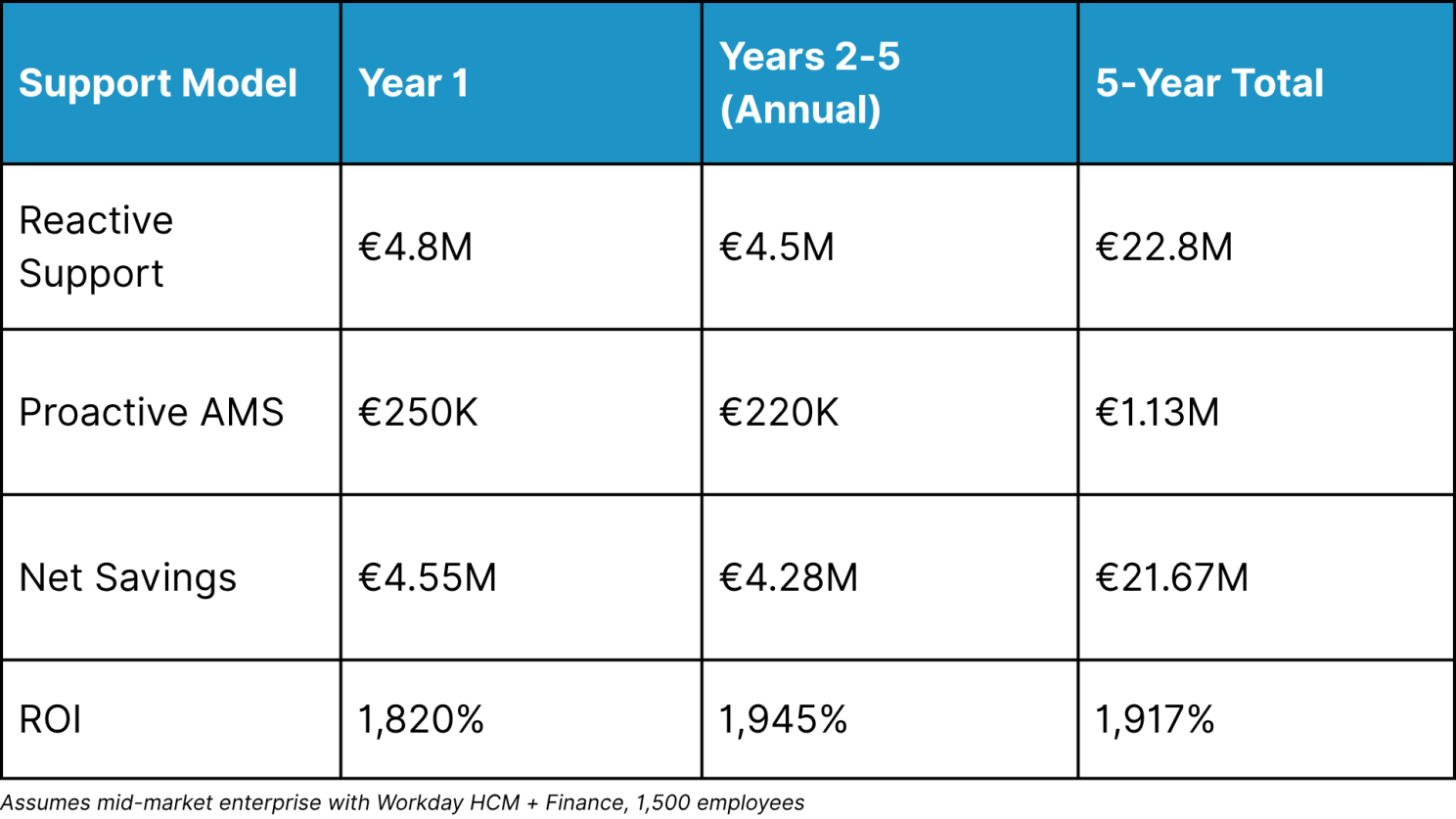
Your Workday system just went down during payroll processing. Employees can’t access their benefits. Your finance team is locked out during month-end close. You scramble to contact support, wait for diagnosis, and watch the clock tick as costs rise. Sound familiar?
For many organizations, this reactive “break-fix” approach to Workday support isn’t just operationally disruptive — it carries hidden financial impacts that never appear as a single invoice, but accumulate quarter after quarter.
The €300,000+ Reality Check
According to ITIC research, 97% of large enterprises report that a single hour of downtime costs more than €100,000. For mid-size and large organizations, the average cost now exceeds €300,000 per hour when Workday supports core HR, payroll, finance, and compliance-critical workflows.
These are not theoretical losses — they show up as:
- Payroll processing delays and employee impact
- Benefits administration disruptions during fixed enrollment windows
- Month-end financial close delays affecting reporting and audits
- Escalated vendor support fees and corrective consulting hours
Internal Workday Team Certification Investment
Many organizations attempt to solve this by upskilling or expanding internal Workday teams. But certification programs for HR, Finance, Integration, and Reporting tracks require significant investment:
- Certification training costs: €8,000–€20,000 per consultant
- Time to mastery: 6–18 months per functional area
- Ongoing release management learning every 6 months
- Risk of turnover after training investment
This often results in teams that are skilled, but still forced into reactive mode — responding to issues instead of preventing them.

Why Reactive Support Fails: The Cascading Business Impact
- Downtime Costs Are Exponential, Not Linear
When mission-critical Workday environments go down, the financial impact multiplies. A company estimating €100,000 per hour of downtime incurs approximately €1,667 per minute for one server. If 10 servers and core business applications are affected, that cost escalates to over €16,670 per minute.During critical business cycles such as payroll processing or year-end close, downtime triggers organizational chain reactions:- Payroll delays impacting 1,500+ employees
- Disruptions to benefits enrollment during limited windows
- Compliance reporting risks against regulatory deadlines
- Finance close delays affecting investor confidence and reporting
2. The Hidden Productivity Drain
According to Workday usage trends, most organizations assign 3–4 internal employees to ongoing application maintenance. On average, teams lose 60–78 hours per month to reactive issue resolution:- Diagnosis & troubleshooting: 24–32 hours
- Vendor coordination & escalation: 16–20 hours
- Temporary workarounds: 12–16 hours
- Post-incident documentation: 8–10 hours
- Total: Nearly 2 full-time employees dedicated to “firefighting” instead of innovation
3. The Update & Optimization Gap
Workday implementation typically costs 100–150% of annual subscription fees. For example, a €300,000 annual license often requires €450,000+ in implementation investment. However, without proactive support, organizations struggle to adopt Workday’s bi-annual enhancements.
Each delayed update means:- Missing automation features that could reduce 200+ hours annually
- Postponing critical security improvements
- Relying on outdated workflows that slow operations
- Delaying ROI on significant upfront investments
4. Increased Compliance & Security Exposure
Reactive support leaves gaps where human error, configuration drift, and unpatched vulnerabilities create risk:- Unapplied security patches between update cycles
- Non-alignment with evolving GDPR and data privacy standards
- Audit difficulties due to outdated governance settings
- Data integrity risks caused by manual process workarounds
The Proactive Alternative: Application Managed Services (AMS)
By investing in proactive AMS, organizations reduce downtime, increase operational agility, accelerate feature adoption, and secure long-term system stability—all while ensuring internal teams can focus on strategic priorities rather than issue resolution.
- Downtime Costs Are Exponential, Not Linear

What Proactive AMS Delivers
Operational Excellence:
- 24/7 system monitoring and issue prevention
- Management of bi-annual updates with regression testing
- Proactive configuration and workflow optimization
- Continuous integration health monitoring and maintenance
Strategic Value:
- Workday feature adoption roadmap aligned with business goals
- Best practice configurations informed by cross-industry experience
- Support for compliance, audit readiness, and secure operations
- Knowledge transfer to strengthen internal Workday capability
Predictable Costs:
- Fixed monthly investment (€18,000–€25,000 for mid-market organizations)
- No surge pricing or emergency response fees
- Update management included at no additional cost
- Transparent SLAs ensuring consistent response and resolution times
The LogicaCloud Approach: Proactive Support Reimagined
At LogicaCloud, we help enterprises break the reactive support cycle. Our Workday AMS is designed to anticipate issues, accelerate optimization, and maximize platform value.
- Dedicated support teams with an average of 8+ years Workday experience
- Continuous monitoring to identify and resolve issues before impact
- Seamless adoption of Workday’s bi-annual releases without downtime risk
- Automated regression testing powered by ilumn for every update
- Flexible engagement models that scale with business complexity
Example: A European manufacturing client reduced unplanned downtime from 14 hours annually to **zero**, while lowering total Workday support spend by **68%** and redirecting budget toward strategic transformation initiatives.
Calculate Your Reactive Support Tax
Your Hidden Cost Formula:
(Annual Downtime Hours × €300,000) +
(Support Staff Time × €65/hour) +
(Delayed Features × Opportunity Cost) +
(Compliance Incidents × Penalty Cost)
For most organizations operating reactively, the total impact ranges from €4M–€6M annually in preventable losses.
Stop Paying the Reactive Tax
The real question isn’t whether you can afford proactive AMS — it’s whether you can afford another year of reactive support draining resources and increasing risk.
Every day on reactive support is another day:
- Increasing exposure to critical downtime
- Paying 10–20x more than proactive prevention
- Falling behind organizations that adopt new features faster
- Burning out IT and HRIS teams on constant issue resolution
Transform Workday from a maintenance burden into a strategic advantage.
